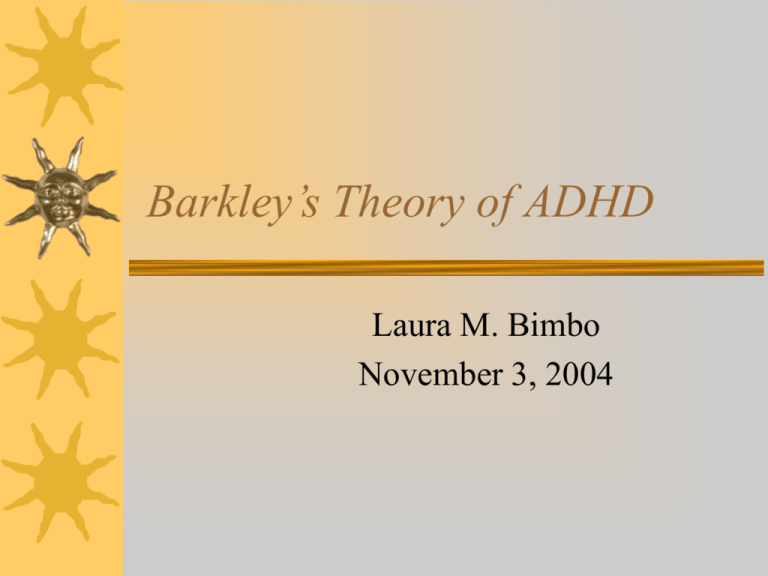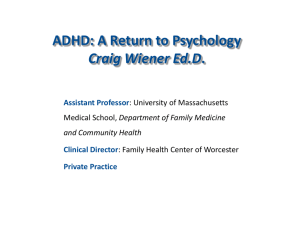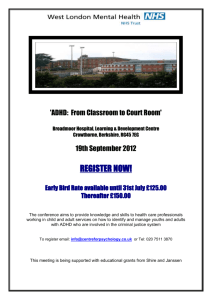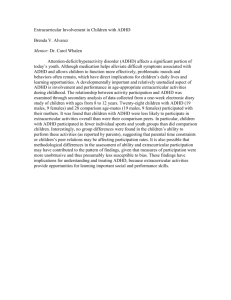Barkley's Theory of ADHD
advertisement

Barkley’s Theory of ADHD Laura M. Bimbo November 3, 2004 DSM-IV ADHD Three core ADHD symptoms: • Hyperactivity • Impulsivity • Inattention Three ADHD subtypes: • Predominately Inattentive • Predominately Hyperactive-Impulsive • Combined Type Attention impairments have been thought to be the central ADHD deficit Why a new theory on ADHD? To date, most research is atheoretical • Descriptive • Exploratory DSM-IV criteria is descriptive only – Observable behavior deficits only Current criteria for ADHD assumes that subtypes represent similar deficits – Individuals with ADHD do not show inattention in all situations (Barkley, 1997) Subtypes = Different Disorders? Hyperactive-Impulsive type is a developmental precursor to Combined type • Preschool children vs. School aged children (Applegate et al., 1995) Combined type = sustained attention and distractibility High rates of ODD/CD comorbidity and other poor outcomes (school suspensions, substance use, etc.) (Barkley, 1997) Subtypes = Different Disorders? Purely Inattentive type usually appears at a later age Inattentive type = deficit in speed of processing; focused & selective attention) Symptoms = daydreaming, “spacing out”, “being in a fog”, hypoactive, “sluggish cognitive tempo” Decreased rates of comorbidities (Barkley, 2001) Barkley’s Theory of ADHD Core impairment = Response Inhibition Due to abnormalities in the prefrontal cortex and connections to other brain regions (striatum) Response Inhibition affects four intermediate executive functions So, poor response inhibition + deficits in executive functions = poor control Barkley also asserts that individuals with ADHD don’t develop “future orientation and sense of self across time” Barkley’s Theory of ADHD Response Inhibition Working Memory Self-Regulation Of Affect/ Motivation/Arousal Internalization Of Speech Motor Control/ Fluency/Syntax Reconstitution Response Inhibition 1. 2. 3. Inhibiting the initial prepotent response to an event. Interrupting an ongoing response, permitting a delay in the decision to respond or continue responding Protecting this period of delay from disruption by competing events and responses (interference control) (Barkley, 1999) Evidence for Poor Response Inhibition in ADHD Behavioral Observations : • Greater activity level (Luk, 1985) • More talkative to others and self (Barkley, et al., 1983; Copeland, 1979) • More difficulty restricting behavior in laboratory settings than other children (Luk, 1985) • Less delay of gratification, less successful at resistance-to-temptation paradigms (Campbell, et al., 1994) Response Inhibition 1. 2. 3. Inhibiting the initial prepotent response to an event. Interrupting an ongoing response, permitting a delay in the decision to respond or continue responding Protecting this period of delay from disruption by competing events and responses (interference control) (Barkley, 1999) Measuring Prepotent Responses Some studies have found no differences between kids with ADHD and those without ADHD on tasks measuring response inhibition Methodological problems: – No immediate reinforcement within the task to encourage prepotent responding – If immediate rewards are provided, they are weak reinforcers for this individual – No history of reinforcement exists, so there is no prepotent response for this individual • (Barkley, 1999) Evidence for Poor Inhibition of Prepotent Responses Go-No-Go Paradigm (Barkley, 1997) Continuous Performance Test – Errors of Commission Stop-Signal Paradigm – Primary task of forced-choice letter discrimination – When presented with a signal (tone), response is inhibited – Kids with ADHD show: • Longer reaction times to signal • Less inhibition of primary response • More variation in their inhibition of primary response Evidence for Poor Inhibition of Prepotent Responses Continuous Performance Test – Errors of Commission During a direct observation study, children with ADHD interrupted more than control children (Malone & Swanson, 1993) Response Inhibition 1. 2. 3. Inhibiting the initial prepotent response to an event Interrupting an ongoing response, permitting a delay in the decision to respond or continue responding Protecting this period of delay from disruption by competing events and responses (interference control) (Barkley, 1999) Evidence for Difficulty Interrupting Ongoing Responses Stop Signal Paradigm Wisconsin Card Sorting Task (WCST) – Involves shifting to a more effective response pattern when feedback indicates that the ongoing response is incorrect – Children with ADHD often perseverate, even when feedback is given (Barkley, 1997) – Interestingly, first-degree relatives of individuals with ADHD are more prone to perseverations Evidence for Difficulty Interrupting Ongoing Responses On an information processing task, children with ADHD were less likely to change their response style (i.e. slow down) after corrective feedback Card Playing Task – Children with ADHD bet on more trials than control subjects, despite increased liklihood of being incorrect Response Inhibition 1. 2. 3. Inhibiting the initial prepotent response to an event Interrupting an ongoing response, permitting a delay in the decision to respond or continue responding Protecting this period of delay from disruption by competing events and responses (interference control) (Barkley, 1999) Evidence for Poor Interference Control Stroop Color-Word Test – Subjects with ADHD (and their siblings) perform poorly when responding to the color of words rather than reading the words (Barkley, 1997) – Differences are also found when comorbid conditions are controlled for – Neuroimaging studies have shown that the right prefrontal region is involved in the performance of this task Barkley’s Theory of ADHD Response Inhibition Working Memory Self-Regulation Of Affect/ Motivation/Arousal Internalization Of Speech Motor Control/ Fluency/Syntax Reconstitution Working Memory Holding information in mind, manipulating or acting on the information Hindsight (retrospection) Foresight (prospection) Empirical evidence in kids with ADHD: – Digit span (especially backwards) – Mental arithmetic Barkley’s Theory of ADHD Response Inhibition Working Memory Self-Regulation Of Affect/ Motivation/Arousal Internalization Of Speech Motor Control/ Fluency/Syntax Reconstitution Self-Regulation of AffectMotivation-Arousal Emotional self-control Social perspective taking Ability to express emotions internally Intrinsic motivation directed at long-term goals Empirical evidence in kids with ADHD: – More negative and emotional peer interactions – Impairment in persistence of effort Barkley’s Theory of ADHD Response Inhibition Working Memory Self-Regulation Of Affect/ Motivation/Arousal Internalization Of Speech Motor Control/ Fluency/Syntax Reconstitution Internalization of Speech Self-directed speech (“private speech”) Formulating rules and plans to solve problems Internal reflection, description, questioning, instructing Create internal rules for governing behavior Empirical evidence in kids with ADHD: – Less compliant with verbal commands – Immature self-directed speech – Develop internal speech at a later age Barkley’s Theory of ADHD Response Inhibition Working Memory Self-Regulation Of Affect/ Motivation/Arousal Internalization Of Speech Motor Control/ Fluency/Syntax Reconstitution Reconstitution Ability to create complex and novel behavior sequences in order to attain future goals (generativity or fluency) Involves analysis and synthesis Empirical evidence in kids with ADHD: – – – – Ideational fluency (Barkley, 1999) Verbal fluency (esp. FAS) Less info and organization in stories (Tannock, 1996) Less creativity during free play (Funk, et al., 1993) Barkley’s Theory of ADHD Response Inhibition Working Memory Self-Regulation Of Affect/ Motivation/Arousal Internalization Of Speech Motor Control/ Fluency/Syntax Reconstitution Motor Control/Fluency/Syntax Deficits in response inhibition and the four executive functions lead to impairments in: – – – – – Control Timing Persistence Flexibility Goal-directed actions Motor Control/Fluency/Syntax Barkley asserts that these deficits manifest in ADHD children through: – Ability to adapt to new information – Ability to predict what will happen – Ability to generate responses to future info ADHD = “nearsighted when it comes to time” or “time blindness” (Barkley, 1999) Motor Control/Fluency/Syntax Problems with sustained attention result from a limited intrinsic motivation for future goals Effectiveness of stimulant medications: – Due to enhancement of inhibitory mechanismsimproved four areas of executive functioning Barkley’s Theory: Limitations Are difficulties in inhibition a result of ADHD or comorbid problems such as aggression, ODD, & learning disabilities How much affect does response inhibition have on the 4 executive functions in the model? How much does each executive function contribute to motor control? Can the 4 executive functions be further reduced? Barkley’s Theory: Limitations Do stimulant medications differentially affect each of the 4 executive functions? Is there some hierarchical organization to the executive functions? Can this model be used to dissociate Inattentivetype ADHD from the other types? Does socialization affect the development of these executive functioning? What gender and ethnic differences exist in the development of these executive functions? Barkley’s Theory: Treatment Implications Basis of treatment Environmental modifications No delay between response and outcomes Breaking down tasks into smaller components Key conceptPoint of performance Barkley’s Theory: Treatment Implications Place key information at the point of performance: – – – – Provide external rewards/motivation Minimize distractions Put clock on student’s desk Display rules at point of performance








